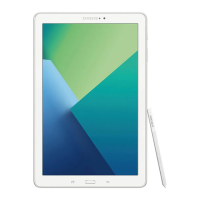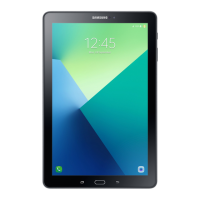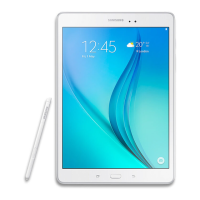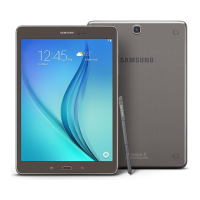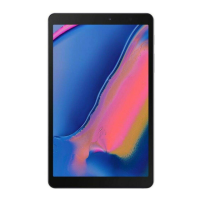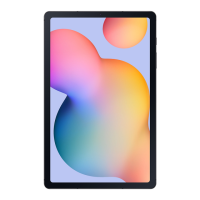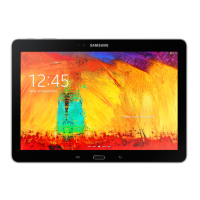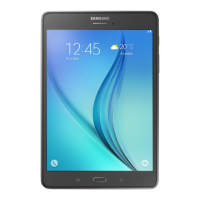Do you have a question about the Samsung SM-P585 and is the answer not in the manual?
Important preliminary information for safe and proper device usage.
Lists items included in the device's product box and accessory guidelines.
Visual guide to the physical components and ports of the device.
Details about the S Pen, its button, nib, and tweezers.
Instructions for safely removing and inserting the S Pen into its slot.
Step-by-step guide on how to replace the S Pen nib.
Instructions for charging the device's battery using the power adapter.
How to check the remaining battery charge and estimated usage time.
Tips and settings to conserve the device's battery power.
Important precautions and tips for charging the device's battery safely.
How to activate and use power saving mode to extend battery life.
Advanced power saving features to maximize battery standby time.
Step-by-step guide for inserting the nano-SIM or USIM card.
Instructions on how to safely remove the SIM or USIM card from the device.
Guide on how to insert a microSD card into the device.
Steps to safely unmount and remove the microSD card.
How to format a microSD card for use with the device.
Instructions for powering the device on and off correctly.
Procedure to force restart the device when it is unresponsive.
Guidelines for using and caring for the device's touchscreen.
Explains tapping and tapping-and-holding actions on the touchscreen.
Details on dragging, double-tapping, and swiping gestures.
How to zoom in and out using pinch gestures on the screen.
Introduction to the Home screen elements and navigation.
Customizing wallpaper, widgets, and panels on the Home screen.
How to add apps and widgets to the Home screen.
Guides on rearranging and deleting items on the Home screen.
Steps to group apps into folders on the Home screen.
Adding, moving, and removing panels from the Home screen.
How to navigate and manage apps in the Apps screen.
Organizing apps into folders within the Apps screen.
Sorting apps alphabetically and searching for specific apps.
Explains common icons displayed in the status bar.
How the device locks and unlocks the screen.
Setting up PIN, pattern, password, or swipe to secure the device.
Accessing and viewing notifications from the status bar.
Using quick setting buttons and managing notifications.
Searching for content on the device and managing search categories.
Explains the on-screen keyboard layout and text entry functions.
Voice input, handwriting mode, emoticons, and keyboard settings.
How to copy, cut, and paste text on the device.
Methods for taking screenshots using buttons or gestures.
Advanced screenshot options like scroll capture, drawing, and cropping.
Launching and closing applications on the device.
Accessing and using Air command features like Create note, Smart select.
Moving and removing the Air command icon from the screen.
Capturing and editing specific areas of the screen with the S Pen.
Writing or drawing on screenshots and capturing scrolling content.
Translating words by hovering the S Pen over them.
Customizing the Air command panel with frequently used apps.
Previewing information by hovering the S Pen over screen items.
Using Air View to preview content in a pop-up window.
Performing actions via Air Button on the preview window.
Selecting multiple items or text using the S Pen.
Writing messages and filling forms using handwriting with the S Pen.
Creating memos by writing on the screen while it's off.
Running multiple apps simultaneously in split-screen or pop-up view.
Instructions for opening and using apps in split-screen mode.
Switching app locations and dragging content between windows.
How to resize split-screen app windows.
Launching and managing apps in pop-up windows.
Overview of the integrated Samsung account service.
Steps to create or sign in to a Samsung account.
How to remove a registered Samsung account from the device.
Using Smart Switch to transfer data from another mobile device.
Backing up data to a computer and importing it to the device using Smart Switch.
Transferring files between the device and a computer.
Updating the device via Smart Switch or over-the-air.
Using Samsung or Google accounts to back up and restore data.
Backing up and restoring data using a Google account.
Resetting the device to factory defaults and its implications.
Overview of connecting to nearby devices like Bluetooth headsets or TVs.
Using Quick connect to find and connect to nearby devices.
Sending content to connected devices via Quick connect.
Viewing device content on a TV using features like Smart View.
Streaming content from the device to a registered TV.
Various methods for sharing content like images via Bluetooth, email, etc.
Downloading and removing apps from Galaxy Apps and Play Store.
Disabling, uninstalling, and managing app permissions.
Making and answering voice and video calls.
Dialing numbers, adding contacts, and making calls.
Setting up and using speed dial for quick calls.
How to make calls when the device is locked.
Steps to make calls to international numbers.
Answering, rejecting, and sending messages during calls.
Adding numbers to the block list and blocking anonymous calls.
Features available during voice calls like volume, mute, and adding calls.
Creating and managing contacts on the device.
Entering contact details and saving them.
Importing contacts from storage services.
Finding contacts and sharing contact information.
Sending and viewing text messages.
Composing and sending text messages with recipients and attachments.
Reading message threads and blocking unwanted messages.
Customizing notification sounds, vibration, and display.
Setting alerts for unchecked notifications.
Navigating websites using the Internet app.
Browsing the internet privately with password protection.
Configuring email accounts for sending and receiving emails.
Composing, sending, and reading emails.
Overview of taking photos and recording videos.
Taking photos and recording videos, zoom, and brightness adjustments.
Accessing quick settings, shooting modes, and camera etiquette.
Quick access to the camera from the locked screen.
Selecting and organizing camera shooting modes.
Using automatic and manual (Pro) modes for photography.
Taking panoramic photos and continuous shots of moving subjects.
Capturing photos with enhanced detail in bright and dark areas.
Using Selfie, Night, Beauty Face, Sports, and Sound & Shot modes.
Adjusting filter effects, sound, metering, timer, and flash.
Video size, grid lines, location tags, and shooting method configurations.
Viewing and managing photos and videos.
Navigating and interacting with images in the Gallery.
Playing videos, adjusting volume, and controlling playback.
Removing single or multiple images and videos.
Sharing images or videos using various methods.
Creating notes with text, handwriting, images, and voice recordings.
Steps to compose new notes using different input methods.
Writing and drawing in notes, changing pen type, thickness, and color.
Erasing handwriting and clearing notes.
Cutting, moving, resizing, and transforming handwritten content.
Selecting, cutting, copying, pasting, and arranging handwritten text.
Painting with brushes and inserting images or voice recordings into notes.
Adding notes to the Home screen and removing them.
Social network for sharing artwork created with the S Pen.
Uploading artwork to PEN.UP and sharing from other apps.
Viewing, commenting, and downloading artwork.
Managing schedules, events, and tasks.
Adding events and tasks to the S Planner.
Synchronizing events and tasks with Google or Samsung accounts.
Accessing and managing files stored on the device.
Using alarms, world clock, stopwatch, and timer.
Configuring and managing alarms.
Creating and deleting world clocks.
Using the stopwatch and timer functions.
Performing calculations with the built-in calculator.
Providing a safe environment for children with restricted access.
Introduction to Google apps like Chrome, Gmail, Maps, etc.
Managing photos and chatting with friends.
Customizing device settings for personalization.
Activating Wi-Fi and connecting to a network.
Direct device-to-device connection using Wi-Fi Direct.
Sending images or files to other devices using Wi-Fi Direct.
Disconnecting from Wi-Fi Direct enabled devices.
Exchanging data with other Bluetooth-enabled devices.
Connecting to and pairing with other Bluetooth devices.
Transferring files and data using Bluetooth.
Removing paired Bluetooth devices from the list.
Disabling all wireless functions for use during flights.
Sharing the device's mobile data connection.
Setting up and using the device as a mobile Wi-Fi hotspot.
Tracking and limiting mobile data consumption.
Setting data limits and usage alerts.
Configuring network modes, roaming, and APNs.
Nearby device scanning and printing settings.
Accelerating large file downloads using Wi-Fi and mobile data.
Installing and activating printer plug-ins for printing.
Sending documents and images to printers.
Managing battery, storage, RAM, and system security.
Improving performance by cleaning memory and scanning for malware.
Checking battery status and managing power saving modes.
Checking and managing device storage and memory.
Closing background apps to improve RAM usage.
Checking the device's security and scanning for malware.
Managing apps, default apps, and app settings.
Customizing sound modes, ringtones, and touch sounds.
Customizing notification previews and lock screen display.
Muting calls and notifications, setting schedules, and allowing exceptions.
Adjusting brightness, font, screen timeout, and screensaver.
Configuring Air command, Air view, direct pen input, and S Pen power saver.
Enabling features like pop-up view, smart capture, and direct share.
Setting up and managing multiple user accounts on the device.
Creating new user accounts and switching between them.
Deleting user accounts and changing their settings.
Changing wallpapers for the Home and lock screens.
Adding, deleting, or rearranging Home screen panels.
Securing the device, info on lock screen, and Find My Mobile.
Unknown sources, secure startup, encrypting SD card, and other security options.
Managing location, app permissions, and private mode.
Hiding and viewing personal content securely.
Unhiding content and automatically deactivating private mode.
Customizing settings for visually impaired, hearing, and dexterity impaired users.
Linking Samsung, Google, and other accounts for syncing.
Managing Samsung accounts for backup and service usage.
Configuring settings for Google services.
Managing settings and data backup/restore.
Google account backup, restore, and reset settings.
Changing display language, keyboard, and voice input.
Viewing battery status and activating power saving modes.
Checking used and available memory capacity.
Configuring accessory settings like automatic unlock.
Setting automatic or manual date and time, and 24-hour format.
Viewing help information and configuring settings.
Viewing device information and updating software.
Explains Password, PIN, PUK, and PIN2 prompts.
Troubleshooting network connectivity and service errors.
Solution for a device that does not power on, likely battery related.
Troubleshooting slow or improper touchscreen response.
Solutions for device freezes, including forcing restart and factory reset.
Ensuring correct network and checking call barring settings.
Troubleshooting issues with the microphone and sound echoes.
Addressing cellular or internet disconnections and poor audio quality.
Indicates low battery; solution is to charge the device.
Troubleshooting issues with the battery not charging properly.
Reasons for faster battery depletion and consumable nature.
Addressing device becoming hot during use.
Resolving error messages when launching the camera app.
Factors affecting photo quality, like lighting and technique.
Troubleshooting errors with opening or playing multimedia files.
Ensuring Bluetooth is active and devices are in range.
Troubleshooting connection issues with computers via USB.
Ensuring GPS, Wi-Fi, or network connectivity for location services.
Importance of backups and Samsung's non-responsibility for data loss.
Explaining the small gap as a manufacturing feature.
Freeing up storage by deleting data or apps.
Copyright information for the manual and Samsung Electronics.
Registered trademarks related to Samsung and Bluetooth.
Important preliminary information for safe and proper device usage.
Lists items included in the device's product box and accessory guidelines.
Visual guide to the physical components and ports of the device.
Details about the S Pen, its button, nib, and tweezers.
Instructions for safely removing and inserting the S Pen into its slot.
Step-by-step guide on how to replace the S Pen nib.
Instructions for charging the device's battery using the power adapter.
How to check the remaining battery charge and estimated usage time.
Tips and settings to conserve the device's battery power.
Important precautions and tips for charging the device's battery safely.
How to activate and use power saving mode to extend battery life.
Advanced power saving features to maximize battery standby time.
Step-by-step guide for inserting the nano-SIM or USIM card.
Instructions on how to safely remove the SIM or USIM card from the device.
Guide on how to insert a microSD card into the device.
Steps to safely unmount and remove the microSD card.
How to format a microSD card for use with the device.
Instructions for powering the device on and off correctly.
Procedure to force restart the device when it is unresponsive.
Guidelines for using and caring for the device's touchscreen.
Explains tapping and tapping-and-holding actions on the touchscreen.
Details on dragging, double-tapping, and swiping gestures.
How to zoom in and out using pinch gestures on the screen.
Introduction to the Home screen elements and navigation.
Customizing wallpaper, widgets, and panels on the Home screen.
How to add apps and widgets to the Home screen.
Guides on rearranging and deleting items on the Home screen.
Steps to group apps into folders on the Home screen.
Adding, moving, and removing panels from the Home screen.
How to navigate and manage apps in the Apps screen.
Organizing apps into folders within the Apps screen.
Sorting apps alphabetically and searching for specific apps.
Explains common icons displayed in the status bar.
How the device locks and unlocks the screen.
Setting up PIN, pattern, password, or swipe to secure the device.
Accessing and viewing notifications from the status bar.
Using quick setting buttons and managing notifications.
Searching for content on the device and managing search categories.
Explains the on-screen keyboard layout and text entry functions.
Voice input, handwriting mode, emoticons, and keyboard settings.
How to copy, cut, and paste text on the device.
Methods for taking screenshots using buttons or gestures.
Advanced screenshot options like scroll capture, drawing, and cropping.
Launching and closing applications on the device.
Accessing and using Air command features like Create note, Smart select.
Moving and removing the Air command icon from the screen.
Capturing and editing specific areas of the screen with the S Pen.
Writing or drawing on screenshots and capturing scrolling content.
Translating words by hovering the S Pen over them.
Customizing the Air command panel with frequently used apps.
Previewing information by hovering the S Pen over screen items.
Using Air View to preview content in a pop-up window.
Performing actions via Air Button on the preview window.
Selecting multiple items or text using the S Pen.
Writing messages and filling forms using handwriting with the S Pen.
Creating memos by writing on the screen while it's off.
Running multiple apps simultaneously in split-screen or pop-up view.
Instructions for opening and using apps in split-screen mode.
Switching app locations and dragging content between windows.
How to resize split-screen app windows.
Launching and managing apps in pop-up windows.
Overview of the integrated Samsung account service.
Steps to create or sign in to a Samsung account.
How to remove a registered Samsung account from the device.
Using Smart Switch to transfer data from another mobile device.
Backing up data to a computer and importing it to the device using Smart Switch.
Transferring files between the device and a computer.
Updating the device via Smart Switch or over-the-air.
Using Samsung or Google accounts to back up and restore data.
Backing up and restoring data using a Google account.
Resetting the device to factory defaults and its implications.
Overview of connecting to nearby devices like Bluetooth headsets or TVs.
Using Quick connect to find and connect to nearby devices.
Sending content to connected devices via Quick connect.
Viewing device content on a TV using features like Smart View.
Streaming content from the device to a registered TV.
Various methods for sharing content like images via Bluetooth, email, etc.
Downloading and removing apps from Galaxy Apps and Play Store.
Disabling, uninstalling, and managing app permissions.
Making and answering voice and video calls.
Dialing numbers, adding contacts, and making calls.
Setting up and using speed dial for quick calls.
How to make calls when the device is locked.
Steps to make calls to international numbers.
Answering, rejecting, and sending messages during calls.
Adding numbers to the block list and blocking anonymous calls.
Features available during voice calls like volume, mute, and adding calls.
Creating and managing contacts on the device.
Entering contact details and saving them.
Importing contacts from storage services.
Finding contacts and sharing contact information.
Sending and viewing text messages.
Composing and sending text messages with recipients and attachments.
Reading message threads and blocking unwanted messages.
Customizing notification sounds, vibration, and display.
Setting alerts for unchecked notifications.
Navigating websites using the Internet app.
Browsing the internet privately with password protection.
Configuring email accounts for sending and receiving emails.
Composing, sending, and reading emails.
Overview of taking photos and recording videos.
Taking photos and recording videos, zoom, and brightness adjustments.
Accessing quick settings, shooting modes, and camera etiquette.
Quick access to the camera from the locked screen.
Selecting and organizing camera shooting modes.
Using automatic and manual (Pro) modes for photography.
Taking panoramic photos and continuous shots of moving subjects.
Capturing photos with enhanced detail in bright and dark areas.
Using Selfie, Night, Beauty Face, Sports, and Sound & Shot modes.
Adjusting filter effects, sound, metering, timer, and flash.
Video size, grid lines, location tags, and shooting method configurations.
Viewing and managing photos and videos.
Navigating and interacting with images in the Gallery.
Playing videos, adjusting volume, and controlling playback.
Removing single or multiple images and videos.
Sharing images or videos using various methods.
Creating notes with text, handwriting, images, and voice recordings.
Steps to compose new notes using different input methods.
Writing and drawing in notes, changing pen type, thickness, and color.
Erasing handwriting and clearing notes.
Cutting, moving, resizing, and transforming handwritten content.
Selecting, cutting, copying, pasting, and arranging handwritten text.
Painting with brushes and inserting images or voice recordings into notes.
Adding notes to the Home screen and removing them.
Social network for sharing artwork created with the S Pen.
Uploading artwork to PEN.UP and sharing from other apps.
Viewing, commenting, and downloading artwork.
Managing schedules, events, and tasks.
Adding events and tasks to the S Planner.
Synchronizing events and tasks with Google or Samsung accounts.
Accessing and managing files stored on the device.
Using alarms, world clock, stopwatch, and timer.
Configuring and managing alarms.
Creating and deleting world clocks.
Using the stopwatch and timer functions.
Performing calculations with the built-in calculator.
Providing a safe environment for children with restricted access.
Introduction to Google apps like Chrome, Gmail, Maps, etc.
Managing photos and chatting with friends.
Customizing device settings for personalization.
Activating Wi-Fi and connecting to a network.
Direct device-to-device connection using Wi-Fi Direct.
Sending images or files to other devices using Wi-Fi Direct.
Disconnecting from Wi-Fi Direct enabled devices.
Exchanging data with other Bluetooth-enabled devices.
Connecting to and pairing with other Bluetooth devices.
Transferring files and data using Bluetooth.
Removing paired Bluetooth devices from the list.
Disabling all wireless functions for use during flights.
Sharing the device's mobile data connection.
Setting up and using the device as a mobile Wi-Fi hotspot.
Tracking and limiting mobile data consumption.
Setting data limits and usage alerts.
Configuring network modes, roaming, and APNs.
Nearby device scanning and printing settings.
Accelerating large file downloads using Wi-Fi and mobile data.
Installing and activating printer plug-ins for printing.
Sending documents and images to printers.
Managing battery, storage, RAM, and system security.
Improving performance by cleaning memory and scanning for malware.
Checking battery status and managing power saving modes.
Checking and managing device storage and memory.
Closing background apps to improve RAM usage.
Checking the device's security and scanning for malware.
Managing apps, default apps, and app settings.
Customizing sound modes, ringtones, and touch sounds.
Customizing notification previews and lock screen display.
Muting calls and notifications, setting schedules, and allowing exceptions.
Adjusting brightness, font, screen timeout, and screensaver.
Configuring Air command, Air view, direct pen input, and S Pen power saver.
Enabling features like pop-up view, smart capture, and direct share.
Setting up and managing multiple user accounts on the device.
Creating new user accounts and switching between them.
Deleting user accounts and changing their settings.
Changing wallpapers for the Home and lock screens.
Adding, deleting, or rearranging Home screen panels.
Securing the device, info on lock screen, and Find My Mobile.
Unknown sources, secure startup, encrypting SD card, and other security options.
Managing location, app permissions, and private mode.
Hiding and viewing personal content securely.
Unhiding content and automatically deactivating private mode.
Customizing settings for visually impaired, hearing, and dexterity impaired users.
Linking Samsung, Google, and other accounts for syncing.
Managing Samsung accounts for backup and service usage.
Configuring settings for Google services.
Managing settings and data backup/restore.
Google account backup, restore, and reset settings.
Changing display language, keyboard, and voice input.
Viewing battery status and activating power saving modes.
Checking used and available memory capacity.
Configuring accessory settings like automatic unlock.
Setting automatic or manual date and time, and 24-hour format.
Viewing help information and configuring settings.
Viewing device information and updating software.
Explains Password, PIN, PUK, and PIN2 prompts.
Troubleshooting network connectivity and service errors.
Solution for a device that does not power on, likely battery related.
Troubleshooting slow or improper touchscreen response.
Solutions for device freezes, including forcing restart and factory reset.
Ensuring correct network and checking call barring settings.
Troubleshooting issues with the microphone and sound echoes.
Addressing cellular or internet disconnections and poor audio quality.
Indicates low battery; solution is to charge the device.
Troubleshooting issues with the battery not charging properly.
Reasons for faster battery depletion and consumable nature.
Addressing device becoming hot during use.
Resolving error messages when launching the camera app.
Factors affecting photo quality, like lighting and technique.
Troubleshooting errors with opening or playing multimedia files.
Ensuring Bluetooth is active and devices are in range.
Troubleshooting connection issues with computers via USB.
Ensuring GPS, Wi-Fi, or network connectivity for location services.
Importance of backups and Samsung's non-responsibility for data loss.
Explaining the small gap as a manufacturing feature.
Freeing up storage by deleting data or apps.
Copyright information for the manual and Samsung Electronics.
Registered trademarks related to Samsung and Bluetooth.
